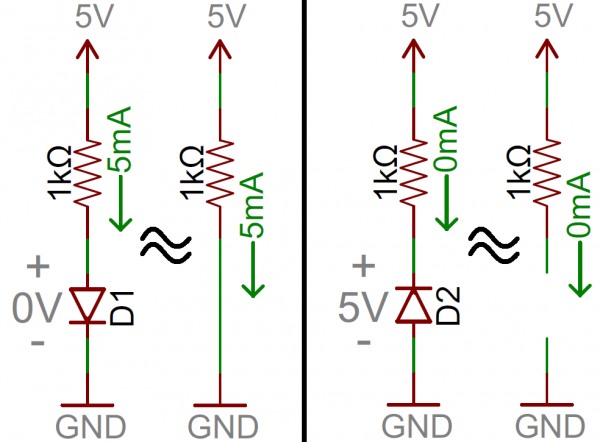Diodes
Ideal Diodes
The key function of an ideal diode is to control the direction of current-flow. Current passing through a diode can only go in one direction, called the forward direction. Current trying to flow the reverse direction is blocked. They're like the one-way valve of electronics.
If the voltage across a diode is negative, no current can flow*, and the ideal diode looks like an open circuit. In such a situation, the diode is said to be off or reverse biased.
As long as the voltage across the diode isn't negative, it'll "turn on" and conduct current. Ideally* a diode would act like a short circuit (0V across it) if it was conducting current. When a diode is conducting current it's forward biased (electronics jargon for "on").
| Ideal Diode Characteristics | ||
| Operation Mode | On (Forward biased) | Off (Reverse biased) |
|---|---|---|
| Current Through | I>0 | I=0 |
| Voltage Across | V=0 | V<0 |
| Diode looks like | Short circuit | Open circuit |
Circuit Symbol
Every diode has two terminals -- connections on each end of the component -- and those terminals are polarized, meaning the two terminals are distinctly different. It's important not to mix the connections on a diode up. The positive end of a diode is called the anode, and the negative end is called the cathode. Current can flow from the anode end to the cathode, but not the other direction. If you forget which way current flows through a diode, try to remember the mnemonic ACID: "anode current in diode" (also anode cathode is diode).
The circuit symbol of a standard diode is a triangle butting up against a line. As we'll cover in the later in this tutorial, there are a variety of diode types, but usually their circuit symbol will look something like this:
The terminal entering the flat edge of the triangle represents the anode. Current flows in the direction that the triangle/arrow is pointing, but it can't go the other way.
Above are a couple simple diode circuit examples. On the left, diode D1 is forward biased and allowing current to flow through the circuit. In essence it looks like a short circuit. On the right, diode D2 is reverse biased. Current cannot flow through the circuit, and it essentially looks like an open circuit.
*Caveat! Asterisk! Not-entirely-true... Unfortunately, there's no such thing as an ideal diode. But don't worry! Diodes really are real, they've just got a few characteristics which make them operate as a little less than our ideal model...


